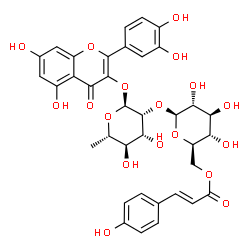Quercetin 3-O-beta-(6''-p-coumaroyl)glucopyranosyl(1->2)-alpha-L-rhamnopyranoside
Modify Date: 2024-01-13 19:18:48

Quercetin 3-O-beta-(6''-p-coumaroyl)glucopyranosyl(1->2)-alpha-L-rhamnopyranoside structure
|
Common Name | Quercetin 3-O-beta-(6''-p-coumaroyl)glucopyranosyl(1->2)-alpha-L-rhamnopyranoside | ||
|---|---|---|---|---|
| CAS Number | 143061-65-8 | Molecular Weight | 756.660 | |
| Density | 1.7±0.1 g/cm3 | Boiling Point | 1092.2±65.0 °C at 760 mmHg | |
| Molecular Formula | C36H36O18 | Melting Point | N/A | |
| MSDS | N/A | Flash Point | 342.0±27.8 °C | |
Use of Quercetin 3-O-beta-(6''-p-coumaroyl)glucopyranosyl(1->2)-alpha-L-rhamnopyranosideQuercetin 3-O-β-D-(6''-p-coumaroyl)glucopyranosyl(1→2)-α-L-rhamnopyranoside (Quercetin-3-O-[2-O-(6-O-p-hydroxyl-E-coumaroyl)-D-glucosyl]-(1→2)-L-rhamnoside) is one of the major antioxidants of Ginkgo biloba leaves[1]. |
| Name | Quercetin-3-O-[2-O-(6-O-p-hydroxyl-E-coumaroyl)-D-glucosyl]-(1-2)-L-rhamnoside |
|---|---|
| Synonym | More Synonyms |
| Description | Quercetin 3-O-β-D-(6''-p-coumaroyl)glucopyranosyl(1→2)-α-L-rhamnopyranoside (Quercetin-3-O-[2-O-(6-O-p-hydroxyl-E-coumaroyl)-D-glucosyl]-(1→2)-L-rhamnoside) is one of the major antioxidants of Ginkgo biloba leaves[1]. |
|---|---|
| Related Catalog | |
| References |
| Density | 1.7±0.1 g/cm3 |
|---|---|
| Boiling Point | 1092.2±65.0 °C at 760 mmHg |
| Molecular Formula | C36H36O18 |
| Molecular Weight | 756.660 |
| Flash Point | 342.0±27.8 °C |
| Exact Mass | 756.190186 |
| LogP | 4.37 |
| Vapour Pressure | 0.0±0.3 mmHg at 25°C |
| Index of Refraction | 1.756 |
| 2-(3,4-Dihydroxyphenyl)-5,7-dihydroxy-4-oxo-4H-chromen-3-yl 6-deoxy-2-O-{6-O-[(2E)-3-(4-hydroxyphenyl)-2-propenoyl]-β-D-glucopyranosyl}-α-L-mannopyranoside |
| QUERCETIN-3-O-(6'''-TRANS-P-COUMAROYL-2''-GLUCOSYL)RHAMNOSIDE |
| 4H-1-Benzopyran-4-one, 3-[[6-deoxy-2-O-[6-O-[(2E)-3-(4-hydroxyphenyl)-1-oxo-2-propen-1-yl]-β-D-glucopyranosyl]-α-L-mannopyranosyl]oxy]-2-(3,4-dihydroxyphenyl)-5,7-dihydroxy- |